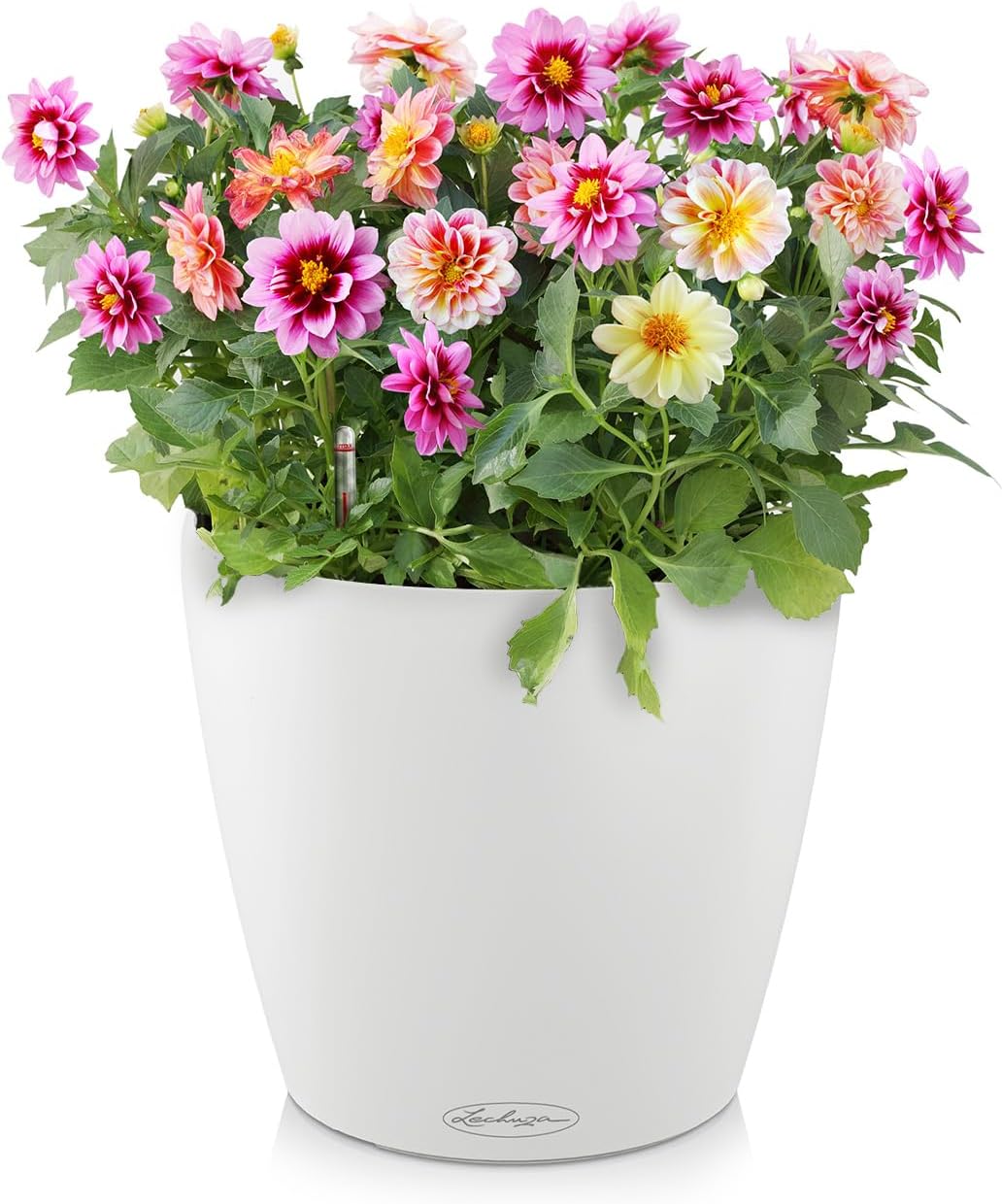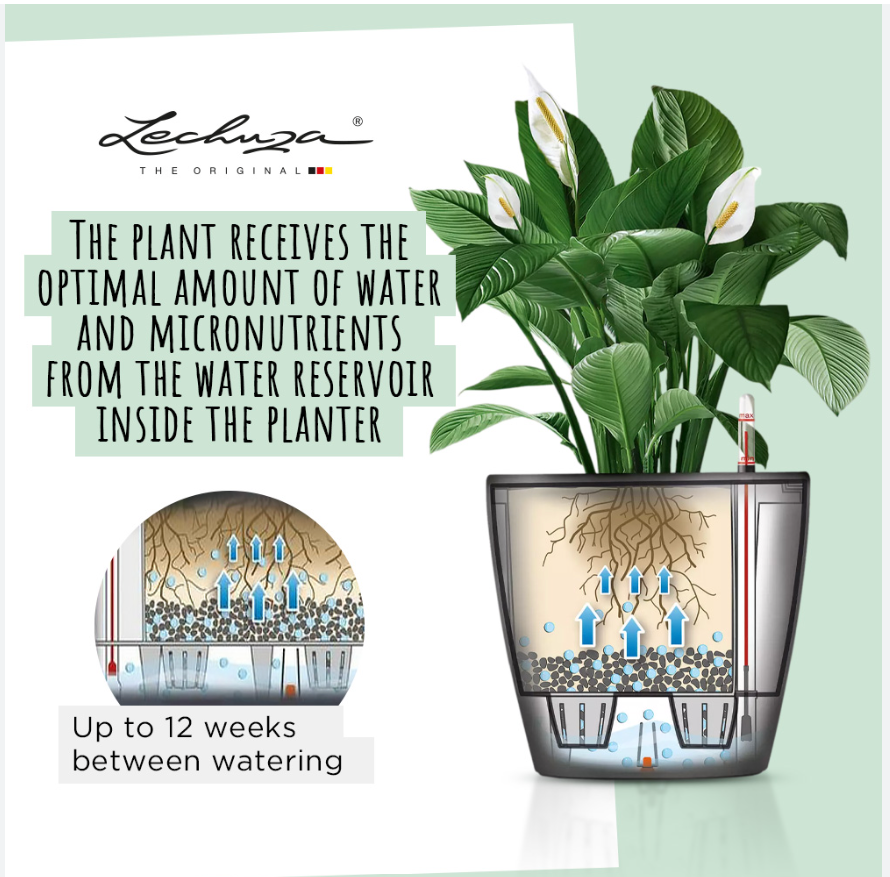The Lechuza Self-Watering Planter is a game-changer for both novice gardeners and seasoned plant enthusiasts. This innovative planter, crafted in Germany, combines sleek design with cutting-edge technology to simplify plant care and promote healthy growth.
Whether you're looking to spruce up your indoor space or add a touch of greenery to your outdoor area, this self-watering planter offers a practical and stylish solution.
One of the standout features of the Lechuza planter is its durability. Made from high-quality, frost and UV-resistant polypropylene (PP) plastic, this planter is built to withstand various weather conditions.
This resilience makes it an excellent choice for both indoor and outdoor use, ensuring that your investment will last for years to come.
The sturdy construction also means you won't have to worry about cracks or fading, even when exposed to harsh sunlight or freezing temperatures.
This feature sets the Lechuza apart from traditional planters, offering a solution to one of the most common challenges in plant care: consistent watering. The system utilizes inorganic granulate compounds that regulate the amount of water delivered to the plant's roots.
Affiliate Disclosure: Some of the links on this website are affiliate links, meaning, at no additional cost to you, we may earn a commission if you click through and make a purchase
This intelligent design confirms that your plants receive the right amount of moisture, reducing the risk of over or under-watering.
The self-watering mechanism works by maintaining a reservoir of water at the bottom of the planter. As the plant's roots grow downward, they can access this water supply as needed. This system promotes healthier root growth and extends the time between watering sessions, making it ideal for busy people or those who travel often.
To further enhance its functionality, the Lechuza planter includes a water-level indicator. This thoughtful addition takes the guesswork out of plant care by clearly showing when it's time to refill the water reservoir.
No more sticking your finger in the soil or lifting heavy pots to check moisture levels – a quick glance at the indicator tells you everything you need to know about your plant's hydration status.
For those planning to use the planter outdoors, Lechuza has incorporated a practical drainage plug. This feature allows for the easy removal of excess rainwater, preventing waterlogging that can be detrimental to plant health.
It's a simple yet effective solution that shows the brand's attention to detail and understanding of diverse gardening needs.
The color line offers a range of sizes to accommodate various plants, from small herbs to larger decorative species. This versatility makes it easy to create cohesive displays or cater to the specific needs of different plants.
The sleek, modern design of the planter complements a wide array of interior and exterior decor styles, adding a touch of sophistication to any space.
One potential drawback to consider is the initial cost. The Lechuza Classico Color planter is priced higher than many traditional planters.
However, when factoring in its durability, self-watering capabilities, and the potential savings on replacement planters and overwatered plants, many users find it to be a worthwhile investment in the long run.
Another aspect to keep in mind is that while the self-watering system is highly effective, it's not entirely hands-off. You'll still need to refill the water reservoir periodically and monitor your plants for signs of distress or disease.
However, the frequency of these tasks is significantly reduced compared to traditional planting methods.
The Lechuza Self-Watering Planter excels in its primary function: making plant care more manageable and effective. Its self-watering system is particularly useful for those who struggle with consistent plant care or for plants that need precise moisture levels.
The durable construction confirms that this planter can withstand the test of time and various environmental conditions, making it a reliable choice for both indoor and outdoor use.
While the price point may be higher than some choices, the combination of quality construction, innovative features, and aesthetic appeal makes the Lechuza Classico Color a valuable addition to any plant lover's collection. It's not just a planter - it's a comprehensive plant care solution that can help your greenery thrive with minimal effort on your part.
For those seeking a low-maintenance, high-performance planting solution, the Lechuza Classico Color Self-Watering Planter offers an impressive blend of form and function.
Revolutionizing Plant Care: The Rise of Self-Watering Planters
In recent years, the gardening world has seen a significant shift towards more innovative and user-friendly solutions for plant care. Among these advancements, self-watering planters have emerged as a game-changing technology, offering a blend of convenience, efficiency, and improved plant health.
This article explores the impact of self-watering planters on modern gardening practices and why they're becoming increasingly popular among both novice and experienced plant enthusiasts.
Understanding Self-Watering Technology
Self-watering planters represent a leap forward in plant care technology. At their core, these planters feature a reservoir system that stores water and gradually releases it to the plant's roots as needed. This innovative design mimics natural water distribution in soil, providing plants with a consistent moisture level that's crucial for optimal growth.
The technology behind self-watering planters typically involves several key components:
- Water Reservoir: A compartment at the base of the planter that holds a supply of water.
- Wicking System: A mechanism that draws water from the reservoir to the soil.
- Soil Separator: A barrier that keeps the soil from becoming waterlogged while allowing roots to access water.
- Overflow Hole: Prevents overwatering by allowing excess water to drain.
This system creates a self-regulating environment where plants can "drink" at their own pace, significantly reducing the risk of over or under-watering.
Benefits of Self-Watering Planters
The adoption of self-watering planters offers many advantages for plant owners:
1. Consistent Moisture Levels
One of the primary benefits of self-watering planters is their ability to maintain consistent soil moisture. This steady water supply is crucial for plant health, promoting stronger root systems and more vigorous growth.
Plants in self-watering containers are less likely to experience the stress associated with fluctuating moisture levels, leading to healthier, more resilient plants.
2. Reduced Watering Frequency
For busy people or those who travel frequently, self-watering planters offer a practical solution to plant care. The water reservoir can often sustain plants for several days or even weeks, depending on the plant's water requirements and environmental conditions.
This reduced need for frequent watering saves time and provides peace of mind for plant owners.
3. Water Conservation
Self-watering planters are inherently more water-efficient than traditional pots. By delivering water directly to the roots and reducing evaporation, these planters can significantly decrease water waste.
This efficiency is particularly useful in regions facing water scarcity or for environmentally conscious gardeners looking to minimize their water usage.
4. Improved Plant Health
The consistent moisture provided by self-watering planters can lead to improved overall plant health. Plants are less likely to experience the stress of drought or overwatering, which can compromise their immune systems and make them more susceptible to pests and diseases.
Additionally, the steady water supply encourages deeper root growth, resulting in stronger, more resilient plants.
5. Versatility in Placement
Self-watering planters offer greater flexibility in terms of where plants can be placed. Areas that might be challenging for regular watering, such as high shelves or outdoor spaces with limited access, become viable options with these low-maintenance containers.
Challenges and Considerations
While self-watering planters offer many benefits, they're not without challenges:
- Initial Cost: Self-watering planters often come with a higher price tag compared to traditional pots.
- Learning Curve: Users may need time to understand how to best use the system for different plant types.
- Potential for Overwatering: Some plants, particularly those adapted to drier conditions, may not thrive in consistently moist soil.
- Maintenance: While reduced, some maintenance is still required, including periodic cleaning of the reservoir and system components.
The Future of Plant Care
As urban gardening continues to gain popularity and people seek ways to incorporate more greenery into their lives with minimal fuss, self-watering planters are poised to play an increasingly important role. The technology behind these planters continues to improve, with some models now incorporating smart features such as moisture sensors and app connectivity for remote monitoring.
The Lechuza Self-Watering Planter exemplifies the benefits of this innovative technology. Its sophisticated design addresses the common challenges of plant care and enhances the aesthetic appeal of indoor and outdoor spaces.
By providing a consistent water supply, reducing maintenance needs, and offering durability for various environments, it represents the cutting edge of modern planting solutions.
As we look to the future, self-watering planters like the Lechuza Classico Color are likely to become increasingly common in homes, offices, and public spaces.
My Experience with the Lechuza Self-Watering Planter
A Game-Changer for Plant Care
As someone who's struggled with keeping plants alive, the Lechuza Self-Watering Planter has been a revelation. The self-watering system does a remarkable job of maintaining consistent moisture levels, and I've noticed a significant reduction in the dreaded "crispy leaf syndrome" that used to plague my indoor garden.
The water level indicator is a godsend - no more guessing games or accidentally drowning my plants.
What's particularly impressive is how well the planter performs in various settings. I've used it both indoors and outdoors, and it's held up beautifully in both environments.
The UV-resistant plastic shows no signs of fading or degradation, even after a full summer on my sun-drenched patio.
And during a particularly harsh winter, the frost-resistant properties proved their worth - my plants survived while those in traditional pots didn't fare so well.
Versatility and Aesthetics
The range of sizes available in the Classico Color line has allowed me to create a cohesive look throughout my home and garden. From small succulents to larger statement plants, there's a size that fits.
The sleek design complements my modern decor, but I can see how it would work just as well in a more traditional setting.
One aspect I particularly appreciate is the drainage plug for outdoor use. Living in an area prone to sudden downpours, I've had issues with waterlogged plants in the past.
The ability to quickly drain excess rainwater has been a real plant-saver.
Frequently Asked Questions
How often do I need to refill the water reservoir?
This depends on the plant's water needs and environmental conditions, but I typically refill every 2-3 weeks for most of my plants.
Can I use regular potting soil in the Lechuza Classico Color planter?
While you can use regular potting soil, I've found that using Lechuza's specially formulated substrate enhances the self-watering function.
Is the Lechuza Classico Color planter suitable for all types of plants?
It works well for most plants, but those requiring very specific watering regimens (like cacti or orchids) might need more careful monitoring.
How do I clean the self-watering system?
I rinse the reservoir and wicking system with warm water every few months. For a deeper clean, a mild soap solution works well.
The Learning Curve
While the Lechuza is largely user-friendly, there was a bit of a learning curve. It took me some time to understand how different plants interacted with the self-watering system.
Some thrived immediately, while others needed adjustments in soil mixture or water levels.
However, once I got the hang of it, the benefits far outweighed the initial trial and error.
One thing to note is that while the self-watering feature significantly reduces maintenance, it doesn't eliminate it entirely. I still check on my plants regularly, prune when necessary, and occasionally supplement with fertilizer.
The planter makes plant care easier, but it's not a complete set-and-forget solution.
Long-Term Value
The durability alone means I won't be replacing it anytime soon, and the improved health of my plants has reduced the need for replacements due to accidental plant deaths.
For apartment dwellers or those with limited outdoor space, the Lechuza Classico Color offers a way to maintain a thriving garden without the need for constant attention. It's been particularly useful for my balcony herbs, which now provide a steady supply for cooking without the daily watering chore.
My Recommendation
While the Lechuza Self-Watering Planter isn't a secret worker, it's come pretty close in my experience. It's an excellent choice for busy plant lovers, frequent travelers, or anyone looking to simplify their plant care routine without sacrificing plant health.
That said, it's important to approach it with realistic expectations.
Get it here!
🌿 Stylish & Smart Watering! Get Your Lechuza Self-Watering Planter Today!


